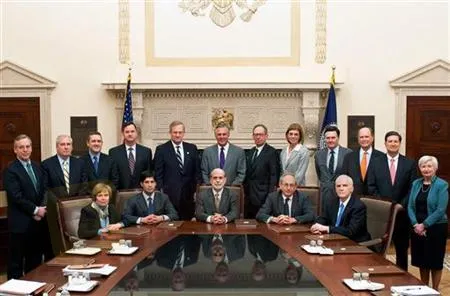简体中文
繁體中文
English
Pусский
日本語
ภาษาไทย
Tiếng Việt
Bahasa Indonesia
Español
हिन्दी
Filippiiniläinen
Français
Deutsch
Português
Türkçe
한국어
العربية
The FOMC Meeting is being traded
Abstract:The Federal Open Market Committee (FOMC) meets eight times a year to talk about and establish monetary policy in the United States. Each meeting is a significant event in the economic calendars of most traders. Speculation in the run-up to the meeting, as well as the aftermath, can cause flashes of volatility as markets respond to the Federal Reserve's choices.

The Federal Open Market Committee (FOMC) meets eight times a year to talk about and establish monetary policy in the United States. Each meeting is a significant event in the economic calendars of most traders. Speculation in the run-up to the meeting, as well as the aftermath, can cause flashes of volatility as markets respond to the Federal Reserve's choices.
Because of the relative secrecy of the meetings, anticipation usually builds as the date approaches. Only the seven governors of the board of governors and the presidents of the five Federal Reserve Banks are allowed to attend. The broad conclusion and significant decisions are disclosed at a press conference shortly afterward, but the complete minutes are not released for another three weeks - another day when market volatility is likely to escalate.
What does the FOMC make a decision on?
When it comes to possible trading possibilities, the markets often rise or fall in response to projected interest rate fluctuations. After evaluating a slew of economic data, the FOMC decides what type of intervention (if any) the US economy requires. It implements measures to raise or reduce interest rates depending on whether it wants to halt or accelerate inflation in order to maintain price stability. The Federal Reserve aims for a 2% annual inflation rate.
The conclusion of the FOMC meeting provides traders with an insight into the official assessment of the health of the US economy. Job growth, the unemployment rate, consumer spending growth, corporate fixed investment growth, and, of course, inflation are all factors considered by the committee.
Outside of the United States, the FOMC meeting is still a significant economic event. Because the United States possesses the world's largest economy, the FOMC's decisions have an impact that extends beyond its boundaries. When debating policy, it's also crucial to remember that the committee examines global economic trends and developments; the committee's hawkish or dovish leanings might provide significant insight into where other central banks may fall.
The FOMC has a direct impact on which financial instruments.
The FOMC has an influence on the following four key asset classes:
Currency pairings in US dollars. Higher interest rates, in general, increase the value of a currency. This is due to the fact that a higher rate tends to attract foreign investment, which in turn boosts demand.
Indices. Interest rate hikes placed downward pressure on consumer and company expenditure, causing stock values to fall. As a result, FOMC speculation frequently affects US indexes.
Bonds. Bond prices rise when interest rates fall and vice versa.
The dollar and gold have a roughly inverse relationship, which means that a weaker dollar can enhance gold's value. Furthermore, gold's reputation as a dependable safe-haven asset may entice investors if the FOMC decision predicts turbulent times ahead for the world or US economies.
Trading concerns at the FOMC
Day traders, in particular, may benefit from trading the FOMC as a risk event. Speculation about the Fed's intentions is typically so intense weeks before the meeting that any predicted interest rate change is essentially priced into the market by the time the meeting is announced.
This implies that if something unexpected occurs, the market may react dramatically. To profit from this turbulence, it's critical to have a thorough awareness of market sentiment and the ability to react swiftly if the Fed surprises and destabilizes markets.
Traders with a longer time horizon should be cognizant of the FOMC's market-moving potential. Any changes in interest rates often take over a year to be fully felt across the economy. As a result, while investigating a possible instrument, this time lag should be included into any investing decisions.

Disclaimer:
The views in this article only represent the author's personal views, and do not constitute investment advice on this platform. This platform does not guarantee the accuracy, completeness and timeliness of the information in the article, and will not be liable for any loss caused by the use of or reliance on the information in the article.
Read more

OANDA Expands TradingView Integration Globally
OANDA completes global TradingView integration, empowering traders in Asia and beyond with seamless access to 1700+ instruments on TradingView charts.

Justice Served: Illegal Investment Scheme Ends in RM28 Million Repayment
The Kuala Lumpur High Court has ruled that a Singaporean businessman, Chan Cheh Shin, must return RM28 million to 122 Malaysian investors after the court determined that his investment operations were conducted illegally.

Tokyo Police Arrest 4 for Unregistered FX Trading Scheme
Four men in Tokyo were arrested for running an unregistered FX trading operation, collecting over ¥1.6 billion from 1,500 investors.

Doo Group Expands Its Operations with CySEC License
Doo Financial, part of Doo Group, receives a CySEC license, allowing FX/CFD services in Europe. This strengthens its global presence and regulatory standards.
WikiFX Broker
Latest News
BSP Shuts Down Uno Forex Over Serious AML Violations
ACY Securities Expands Global Footprint with South Africa Acquisition
Tokyo Police Arrest 4 for Unregistered FX Trading Scheme
Rupee gains against Euro
Axi Bids AUD 52M to Acquire Low-Cost Broker SelfWealth, Outbidding Competitor Bell Financial
Crypto Influencer's Body Found Months After Kidnapping
US Regulators Tighten Oversight on Bank Anti-Money Laundering Efforts
Doo Group Expands Its Operations with CySEC License
RM900,000 Scammed: The Hidden Dangers of Online Investment Schemes
5 Advantages of Choosing a Regulated Broker
Currency Calculator



